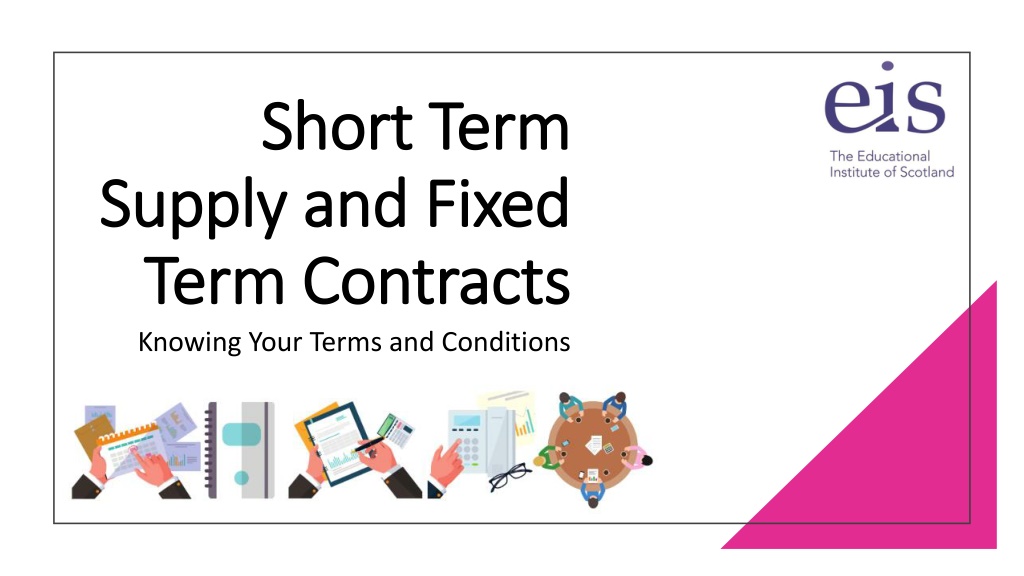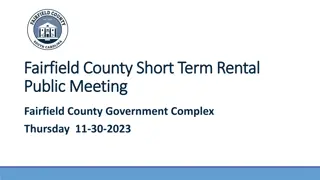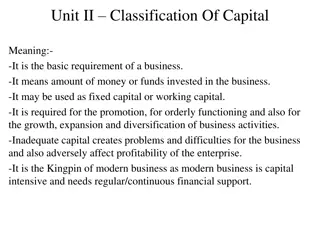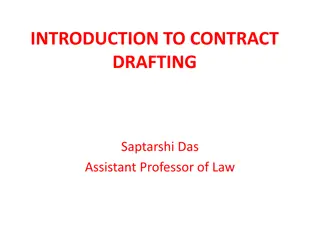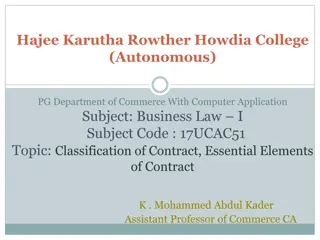Understanding Short-Term and Fixed Supply Contracts in Teaching
Exploring the differences between short-term and fixed-term supply contracts for teachers in Scotland, covering national and local negotiations, SNCT codes of practice, and the roles of EIS representatives. Learn about the contractual terms, conditions, and responsibilities involved in these types of engagements.
Download Presentation

Please find below an Image/Link to download the presentation.
The content on the website is provided AS IS for your information and personal use only. It may not be sold, licensed, or shared on other websites without obtaining consent from the author. Download presentation by click this link. If you encounter any issues during the download, it is possible that the publisher has removed the file from their server.
E N D
Presentation Transcript
Short Term Short Term Supply and Fixed Supply and Fixed Term Contracts Term Contracts Knowing Your Terms and Conditions
A Look at the Definitions National and Local Negotiations SNCT Code of Practice Short Term Supply- Duties and Pay Fixed Term Contracts- Duties and Pay What to Expect from the Employer EIS Structures and How to Get Involved FAQ s and Next Steps What What We Will We Will Cover Cover
Definitions Definitions Supply or Fixed Term Contract? Supply or Fixed Term Contract? Short-Term Supply: Short term engagements of up to two days. Fixed Term / Temporary: Engagement of three days and over.
Nationally Nationally Negotiated Negotiated Terms and Terms and Conditions Conditions The Conditions of Service for all teachers working in local authorities in Scotland are determined through the Scottish Negotiating Committee for Teachers (SNCT). The SNCT sets a number of your contractual terms and conditions at national level, including: o Pay o Sickness Allowances o Class Size Maxima o Maternity/ Parental Leave and Pay The EIS has the largest number of representatives on the teachers panel of the SNCT. EIS representatives are elected teachers, ensuring a strong link between those negotiating your terms and conditions and the realities in the classroom. Your full terms and conditions are contained in the SNCT handbook and can be accessed via www.snct.org.uk.
Locally Locally Negotiated Negotiated Terms and Terms and Conditions Conditions SNCT devolves a number of matters to Local Negotiating Committees for Teachers (LNCTs) EIS representatives negotiating at LNCT level are practicing teachers Many of these devolved matters have particular relevance for those engaged in supply work or fixed term contracts They include: o cover agreements, o appointment procedures, o specific duties and job remits, o transfer of temporary teachers to permanent staff, o leave and absence arrangements and o disciplinary and grievance procedures. They can be found in the LNCT section of the SNCT website: https://www.snct.org.uk/lnctAgreements.php
SNCT Codes of Practice SNCT Codes of Practice Local authorities as employers are required to draw attention to the two main SNCT Codes of Practice of relevance to those engaged in supply work. Appendix 2.8 - Code of Practice on the use of Temporary Contracts. Appendix 2.8A - Code of Practice on Short- Term Supply. www.snct.org.uk
Some of the main duties of teachers on short-term supply differ from those engaged on fixed/long-term contracts. Short Term Short Term Supply: Supply: Duties Duties The main duties of teachers engaged in short-term supply are to: Teach assigned classes Correct work, as part of ongoing classwork Maintain a record of work Contribute towards good order in the school
Pay for short-term supply is calculated on the hourly rate 235 Days x 7 Hours of the annual rate of salary for teachers. Rate will depend on the incremental point on the Main Grade Scale that the teacher qualifies for All those engaged in short-term supply receive a 10% uplift in their pay for preparation and correction time. Supply teachers may only be engaged in a full or half day block. No cap on the maximum class contact time for short-term supply teachers. Short Term Short Term Supply: Pay Supply: Pay Those having difficulty calculating rate of pay should contact payroll department
Fixed Term Contracts: Duties Fixed Term Contracts: Duties Expected to carry out the main duties of all class teacher Subject to the policies/practice of the school/local authority These duties include: - manage and organise classes through planning and preparing for teaching and learning assess, record and report on the work of pupils progress to inform a range of teaching and learning approaches prepare pupils for examinations and where required, assist with their administration contribute towards good order and the wider needs of the school develop the school curriculum contribute to the school and council planning and improvement processes. maintain and develop knowledge and skills and contribute to the professional development of colleagues including probationary and student teachers.
Fixed Term Contracts: Pay Fixed Term Contracts: Pay Those engaged on fixed term contracts are paid in the same manner as those on permanent contracts. Pay Point Annual Salary 0 27,498 1 32,994 The details on how teachers pay is calculated are contained in the Part 2, Appendix 2.19 (National Pay and Leave Specification of the SNCT Handbook). A link to this can be found below. 2 34,863 3 36,891 4 39,231 5 41,412 SNCT Handbook, Part 2, Appendix 2.19
What to Expect From Your Employer: What to Expect From Your Employer: Short-Term Supply Local authority employers must: ensure short-term supply is managed correctly and efficiently. must carry out the actions as set out in Code of Practice on Short-Term Supply (SNCT Appendix 2.8A Fixed Term Contracts Local authority employers should: - ensure a fixed term or temporary contract is issued in accordance with nationally agreed SNCT conditions of service and the relevant local devolved procedures. *Employers need to make any contract permanent after four years consecutive service.
What to Expect From Each School: What to Expect From Each School: Headteacher responsibility to ensure engaged in accordance with Code of Practice. You should be afforded all the relevant information you require including: School day timings. Class timetable Planned work / lesson plans. Medical Action Plans and Additional Support for Learning information Relevant Child Protection documentation. Class registration details / details of registration process. Access to Resources such as stationery and IT equipment.
Check - is practice in line with SNCT Appendix 2.8 (fixed term / temporary contracts) or Appendix 2.8A (short- term supply) What To Do What To Do If Things If Things Aren t Right: Aren t Right: If there are issues make contact with your EIS School Representative. For advice contact your EIS Local Association Secretary or Area Officer. https://www.eis.org.uk/Contacts/LocalAssociation https://www.eis.org.uk/Contacts/Area-Offices
EIS Support EIS Support and Getting and Getting Involved Involved Find out who the EIS Reps are in your school Identify your EIS Local Association Secretary Visit the LNCT sections of the SNCT website- know where to go for local agreements www.snct.org.uk Attend EIS Branch meetings Find out about events/ training on offer through your EIS Local Association If your school does not have a rep contact your Local Association Secretary and Organiser https://www.eis.org.uk/Contacts/Organisers
EIS Structures EIS Structures and Decision and Decision Making Making
FAQs and FAQ s and Next Steps Next Steps
